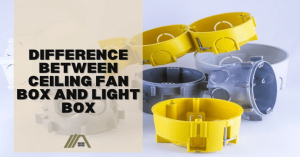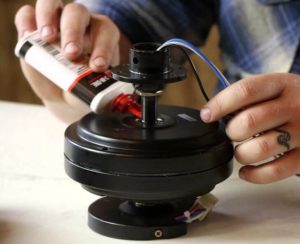Using counterclockwise rotation as the ceiling fan direction for the summer is often considered the optimal choice. However, this statement oversimplifies the matter, especially when you have an HVAC or central air system in place. The effectiveness of the ceiling fan direction greatly depends on the specific placement of return vents and registers within your home.
There are four main configurations to consider, each with its advantages and disadvantages. These configurations involve the positioning of low or high return vents or registers. They impact various factors such as the efficient removal of hot air, the even distribution of cold air, and the wind chill effect.
Clockwise ceiling fan rotation works best when paired with low registers and high returns. Similarly, for optimal performance, low registers and low returns are most effective with clockwise rotation. On the other hand, counterclockwise rotation is ideal when combined with high registers and high returns. High registers and low returns yield the best results with counterclockwise rotation.
Return/Register Location Determines Correct Direction
Return vents and registers can be found in various locations within a room, including the ceiling, floor, and walls near the ceiling or floor.
The positioning of these vents and registers plays an important role in determining the most suitable ceiling fan direction. It determines whether the central air system is compatible with the natural airflow or opposes it.
In general, it is advisable to work with the natural flow of air for optimal results.
Additionally, the relative placement of the return vents in relation to the supply registers can affect the airflow dynamics within the room.
Low Registers and High Return Vents
The configuration of low supply registers and high return vents is not the most effective when the objective is to cool a room. However, it can be considered a somewhat suboptimal setup, rather than the worst possible configuration.
One drawback of this arrangement is that the cold air is introduced at the floor level. Since cold air is denser and tends to descend, it primarily remains close to the floor. Consequently, it doesn’t contribute significantly to cooling the occupants of the room, except for chilling their feet and legs.
There is a benefit to having high return vents in this configuration. As hot air naturally rises, the high return vents prove to be beneficial to become an ideal means for the easy removal of hot air that has accumulated near the ceiling.
The process of extracting air from the top of the room results in a downward flow of air from the lower areas, where the cooled air is supplied. Consequently, the colder air circulates throughout the room, contributing to the cooling of the occupants. However, this airflow can be enhanced by incorporating a ceiling fan.
For optimal results, a clockwise-turning ceiling fan is recommended since it also helps draw air upwards. This facilitates the movement of cold air trapped near the floor to the level where it can be felt by the room’s occupants. This creates a cycle of air circulation, repeatedly forcing the cold air upwards and then allowing it to descend.
One possible downside of using a clockwise-turning ceiling fan is the displacement of warm air near the ceiling by the colder air. This displacement may cause the warm air to move downwards. However, the impact of this effect is typically limited or negligible since the high vents should effectively remove the warm air before it is pushed back down.
It’s worth noting that the clockwise rotation of the ceiling fan does not produce a wind chill effect. The wind chill effect occurs when moving air blows away the thin layer of heat naturally forming around a person’s skin, promoting greater body heat loss.
Low Registers and Low Return Vents
Out of the four configurations discussed in this article, the combination of low registers and low return vents is undeniably the least favorable option.
With low registers, you get the same issue as the previous configuration where cold air is supplied at the floor level and tends to remain there due to the natural sinking of cold, dense air.
However, in this case, an additional problem arises because the low return vents remove the cold air before it can effectively circulate throughout the room. As a result, the cooling effect is limited primarily to your feet and legs, offering little relief elsewhere.
To overcome these limitations, a clockwise-rotating ceiling fan can be used to bring the cold air upwards and disperse it across the room, enabling more effective cooling for the occupants.
Nevertheless, it’s important to note that this approach may result in warmer air near the ceiling being displaced and forced downwards, slightly raising the room temperature (though not significantly). Consequently, you might find yourself adjusting the thermostat to a lower setting compared to using higher return vents.
Additionally, it’s worth mentioning that a clockwise-rotating fan does not generate a wind chill effect.
High Registers and High Return Vents
The configuration of high registers and high return vents stands out as the most useful when the aim is to cool your home using central air.
The placement of high registers allows cool air to naturally descend through the occupied space of the room, preventing it from being trapped in the lower regions.
Moreover, high return vents facilitate the removal of warm air that naturally rises. While there is a possibility that some of the supplied cool air may be extracted by the return vents before it fully sinks, the impact is not as noticeable compared to when both the returns and registers are positioned low.
Integrating a ceiling fan with the central air system further enhances this setup, promoting a more comfortable home temperature while optimizing energy consumption.
In summer, the ideal ceiling fan direction with vents/registers near the ceiling would be counterclockwise, commonly known as the summer mode.
By using counterclockwise fan movement, the natural sinking of cold, dense air is expedited. This creates a downward push of air, maximizing cooling efficiency.
Additionally, the active airflow from the fan generates a wind chill effect as it blows directly onto you, accelerating heat loss processes.
As the wind chill effect creates a sensation of feeling colder without altering the room temperature as the central air does, you can set the thermostat higher, reducing electricity consumption.
High Registers and Low Return Vents
While the configuration of low registers and high-return vents can be considered somewhat semi-poor, the arrangement of high registers and low-return vents can be viewed as a moderately favorable setup.
With high registers, the supply of cold air is positioned higher, allowing it to naturally descend and distribute colder temperatures throughout the occupied space.
On the other hand, the presence of low vents results in the removal of the settling cold air near the floor, where the vents are located. This active extraction of cold air from the lower region aids in pulling the air down and facilitating its movement through the occupied space.
However, the drawback of low vents in this configuration is the inadequate removal of warm air concentrated near the ceiling due to the absence of vents in that area.
Similar to the previous scenario, counterclockwise rotation of the ceiling fan proves to be the most effective in this configuration. By forcing the air downward, it assists in the natural process of cold air sinking and enhances the distribution of cold air throughout the occupied space.
Furthermore, counterclockwise rotation generates a useful wind chill effect.



